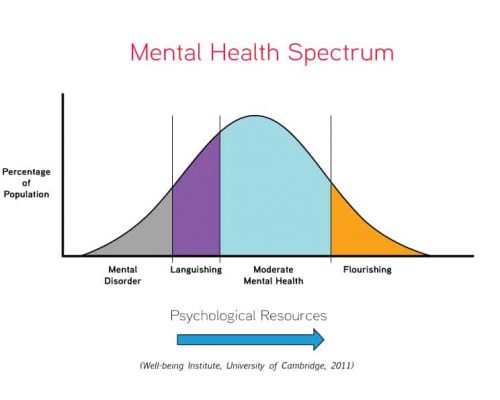Blog
OCTOBER
Understanding the health of mental health?
October is Mental health awareness month and as such we decided to focus this month on the health aspect instead of the illness aspect of mental health. If we consider the following graph published by the Well-Being Institute in 2011 it is clear that the larger part of the general population falls into the moderate mental health category. This may be why the field of positive psychology is currently showing tremendous growth.
Positive psychology is a branch in the psychology field particularly interested in the health aspect and Martin Seligman is seen as the father of positive Psych. In this months videos we will be discussing what is meant with the term Positive Psychology, how to develop some of these practises in our lives, as well as discussing another relatively new term in the Positive Psychology field namely Grit.
Positive psychology is the scientific study of human flourishing, and an applied approach to optimal functioning. It has also been defined as the study of the strengths and virtues that enable individuals, communities and organisations to thrive (Gable & Haidt, 2005, Sheldon & King, 2001).
Positive Psychology is grounded in the belief that people want to lead meaningful and fulfilling lives, to cultivate what is best within them, and to enhance their experiences of love, work, and play (Positive Psychology Centre, 2016).
Robert Biswas-Diener explains it as follows – “Positive Psychology is not a self-help movement or a re-packaging of “the power of positive thinking.” It is not American-style “happy-ology,” and it is not a passing fad (fashion). Positive Psychology is a science focusing on the question of how and when people flourish.”
The field is intended to complement, not to replace traditional psychology. It does not seek to deny the importance of studying how things go wrong, but rather to emphasize the importance of using the scientific method to determine how things go right.

Martin Seligman's (2003) Authentic Happiness Theory
Martin Seligman’s (2003) Authentic Happiness Theory asserts there are three roads to the good life (or positive mental health and wellbeing):
- The Pleasurable Life (Positive Emotions)
- The Engaged Life (Flow and Mindfulness)
- The Meaningful Life (Meaning and Purpose)
In 2011 Seligman revised his Authentic Happiness Theory, renaming it Well-being Theory. His new model (PERMA) includes two additional components: Positive Relationships and Accomplishment. The PERMA model:
PERMA can be obtained by focusing on
– Rise to life’s challenges, make most of setbacks and adversity
– Engage and relate to other people
– Find fulfilment in creativity and productivity
– Look beyond oneself and help others to find lasting meaning, satisfaction, and wisdom (Keyes & Haidt, 2004)